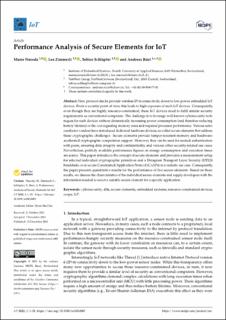Please use this identifier to cite or link to this item:
https://doi.org/10.21256/zhaw-23930| Publication type: | Article in scientific journal |
| Type of review: | Peer review (publication) |
| Title: | Performance analysis of secure elements for IoT |
| Authors: | Noseda, Mario Zimmerli, Lea Schläpfer, Tobias Rüst, Andreas |
| et. al: | No |
| DOI: | 10.3390/iot3010001 10.21256/zhaw-23930 |
| Published in: | IoT |
| Volume(Issue): | 3 |
| Issue: | 1 |
| Page(s): | 1 |
| Pages to: | 28 |
| Issue Date: | 2021 |
| Publisher / Ed. Institution: | MDPI |
| ISSN: | 2624-831X |
| Language: | English |
| Subjects: | Cybersecurity; DTLS; Secure element; Embedded system; Resource-constrained device; Coaps; IoT |
| Subject (DDC): | 004: Computer science |
| Abstract: | New protocol stacks provide wireless IPv6 connectivity down to low power embedded IoT devices. From a security point of view, this leads to high exposure of such IoT devices. Consequently, even though they are highly resource-constrained, these IoT devices need to fulfil similar security requirements as conventional computers. The challenge is to leverage well-known cybersecurity techniques for such devices without dramatically increasing power consumption (and therefore reducing battery lifetime) or the cost regarding memory sizes and required processor performance. Various semi-conductor vendors have introduced dedicated hardware devices, so-called secure elements that address these cryptographic challenges. Secure elements provide tamper-resistant memory and hardware-accelerated cryptographic computation support. Moreover, they can be used for mutual authentication with peers, ensuring data integrity and confidentiality, and various other security-related use cases. Nevertheless, publicly available performance figures on energy consumption and execution times are scarce. This paper introduces the concept of secure elements and provides a measurement setup for selected individual cryptographic primitives and a Datagram Transport Layer Security (DTLS) handshake over secure Constrained Application Protocol (CoAPs) in a realistic use case. Consequently, the paper presents quantitative results for the performance of five secure elements. Based on these results, we discuss the characteristics of the individual secure elements and supply developers with the information needed to select a suitable secure element for a specific application. |
| URI: | https://digitalcollection.zhaw.ch/handle/11475/23930 |
| Fulltext version: | Published version |
| License (according to publishing contract): | CC BY 4.0: Attribution 4.0 International |
| Departement: | School of Engineering |
| Organisational Unit: | Institute of Embedded Systems (InES) |
| Appears in collections: | Publikationen School of Engineering |
Files in This Item:
| File | Description | Size | Format | |
|---|---|---|---|---|
| 2021_Noseda-etal_Performance-analysis-secure-elements-IoT.pdf | 3.46 MB | Adobe PDF |  View/Open |
Show full item record
Noseda, M., Zimmerli, L., Schläpfer, T., & Rüst, A. (2021). Performance analysis of secure elements for IoT. IoT, 3(1), 1–28. https://doi.org/10.3390/iot3010001
Noseda, M. et al. (2021) ‘Performance analysis of secure elements for IoT’, IoT, 3(1), pp. 1–28. Available at: https://doi.org/10.3390/iot3010001.
M. Noseda, L. Zimmerli, T. Schläpfer, and A. Rüst, “Performance analysis of secure elements for IoT,” IoT, vol. 3, no. 1, pp. 1–28, 2021, doi: 10.3390/iot3010001.
NOSEDA, Mario, Lea ZIMMERLI, Tobias SCHLÄPFER und Andreas RÜST, 2021. Performance analysis of secure elements for IoT. IoT. 2021. Bd. 3, Nr. 1, S. 1–28. DOI 10.3390/iot3010001
Noseda, Mario, Lea Zimmerli, Tobias Schläpfer, and Andreas Rüst. 2021. “Performance Analysis of Secure Elements for IoT.” IoT 3 (1): 1–28. https://doi.org/10.3390/iot3010001.
Noseda, Mario, et al. “Performance Analysis of Secure Elements for IoT.” IoT, vol. 3, no. 1, 2021, pp. 1–28, https://doi.org/10.3390/iot3010001.
Items in DSpace are protected by copyright, with all rights reserved, unless otherwise indicated.